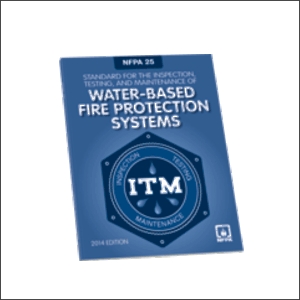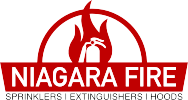Fire Code Inspections
The NFPA 25: Standard for the Inspection, Testing, and Maintenance of Water-Based Fire Protection Systems, 2014 provides Niagara Fire with the policies to be adhered to for fire code inspections.
 Here you will find the list of maintenance and inspection requirements as required by the Ontario Fire Code:
Here you will find the list of maintenance and inspection requirements as required by the Ontario Fire Code:
DAILY to 6 MONTHS - MAINTENANCE OF SPRINKLER & FIRE ALARM EQUIPMENT
EVERY DAY
- All exit lights should be checked for damage and proper operation. (2.7.3.1./2.)
- Check fire alarm AC power light and trouble light. (5.17.3.2.)
- Check trouble conditions indicated on the fire alarm. (6.3.2.1.)
- Check central alarm and control facility functions. (6.3.2.2.)
- Check heating equipment for fire protection water tanks during cold weather. (6.6.2.2./3./4.)
- Check fire pump room temperature during cold weather. (6.6.3.2.)
- Check that unsupervised sprinkler system control valves are open. (6.5.3.1.)
- Check that air pressure on dry pipe systems is being maintained. (6.5.3.3.)
- Inspect valves controlling fire protection water supply. (6.6.1.2.)
- Check water level and air pressure for pressure water tanks. (6.6.2.12.)
- Inspect relief valves on air and water supply lines of pressure tanks. (6.6.2.13.)
- Check water level in fire pump reservoirs. (6.6.3.1.)
- Operate and inspect fire pump. (6.6.3.3./4.)
EVERY MONTH
- Inspect all doors in fire separations. (2.2.3.4.)
- Emergency lighting systems to be inspected. (2.7.3.3.)
- Inspect all portable fire extinguishers. (6.2.7.2.)
- Check all fire alarm components including standby power batteries. (6.3.2.1
- Test fire alarm system. (6.3.2.1.)
- Test voice communication to and from all floors and areas. (6..3.2.3.)
- Inspect all fire hose cabinets. (6.4.2.1.)
- Test the sprinkler system alarm test connection. (6.5.5.2.)
- Inspect water level in gravity tanks. (6.6.2.8.)
EVERY 2 MONTHS
- Test sprinkler system central station connections. (6.5.5.7.)
EVERY 3 MONTHS
- Conduct a fire alarm drill in all high-rise buildings. (2.8.3.2.)
- Test all fire safety devices as by the Subsection 3.2.6. of the building code. (7.2.1.1.)
- Inspect fire protection system for commercial cooking equipment. (2.6.1.13.)
- Test gate valve supervisory switches and other sprinkler & fire protection system supervisory devices. (6.5.5.7.)
- Check and clean crankcase, breathers, governors & linkages on the emergency generator sets. (6.7.1.1.)
- Conduct inspection and maintenance of special extinguishing systems. (6.8.1.)
1 YEAR to 12 YEAR - MAINTENANCE OF SPRINKLER & FIRE ALARM EQUIPMENT
EVERY YEAR
- Inspect all fire dampers and fire stop flaps. (2.2.3.7.)
- Inspect disconnect switches for mechanical conditioning and ventilation. (2.6.1.8.)
- Conduct Fire alarm drills in all buildings which have a fire alarm system. (2.8.3.2.)
- Fire alarm system to be tested by a C.F.A.A. certified technician. (6.3.2.1.)
- Check all fire alarm components including standby power batteries. (6.3.2.1.)
- Remove caps on fire department connections and inspect for wear, rust or obstructions. (Standpipe Systems) (6.4.1.2.)
- Test all standpipe hose valves. (6.4.2.4.)
- Re-rack all standpipe fire hoses. (6.4.2.5.)
- Inspect all exposed sprinkler system pipe hangers. (6.5.3.2.)
- Check all sprinkler heads. (6.5.3.5.)
- Inspect dry pipe valve priming level. (6.5.4.3.)
- Remove caps on fire department connections and inspect for wear, rust or obstructions. (Sprinkler Systems) (6.5.4.4.)
- Test water flow on wet sprinkler system, using remote test connection. (6.5.5.3.)
- Trip test dry pipe trip system. (6.5.5.4.)
- Conduct a main drain flow test of the sprinkler system water supply. (6.5.5.5.)
- Inspect fire protection water supply tanks. (6.6.2.1.)
- Inspect cathodic protection of fire protection water supply tanks. (6.6.2.7.)
- Inspect all parts of the gravity tanks. (6.6.2.9.)
- Test fire pump at full rated capacity. (6.6.3.5.)
- Inspect all fire hydrants on private property. (6.6.5.1.)
- Inspect all fire hydrant water flow. (6.6.5.7.)
- Conduct general engine and generator maintenance & engine tune-ups for emergency generator sets. (6.7.1.1.)
- Check for corrosion on the fire protection water supply tanks. (6.6.2.5.)
- Inspect fire protection water tanks connected to non-portable water supply for sediment (6.6.2.6.)
- Check valve adjustments and torque heads for emergency generator. (6.7.1.1.)
- Clean injector nozzles and check valve adjustments for emergency generators. (6.7.1.1.)
- - Hydrostatic test of carbon dioxide and water type fire extinguishers. (6.2.7.1.)
- - Dry chemical extinguishers shall be emptied and proper maintenance provided. (6.2.7.1.)
- - Conduct hydrostatic testing of dry chemical fire extinguishers as required. (6.2.7.1.)
Contact us to do your inspections
Servicing Niagara, Hamilton, Oakville, Toronto, GTA, Barrie.
Niagara Fire – Referral Program
Complete this form to send us a referral and receive an awesome gift?
What Our Clients Say...

“
Rob informed us of current regulations, inspected and replaced expired extinguishers, tested our emergency lighting and replaced a faulty smoke detector with a dual smoke/carbon monoxide detector. Efficient and at an affordable price.

